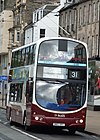
Edinburgh Waverley railway station is the principal railway station serving Edinburgh, Scotland. It is the second busiest station in Scotland, after Glasgow Central. The station serves as the northern terminus of the East Coast Main Line, 393 miles 13 chains from London King's Cross, although some trains operated by London North Eastern Railway continue to other Scottish destinations beyond Edinburgh.

The Fife Circle Line is the local rail service north from Edinburgh. It links towns of south Fife and the coastal towns along the Firth of Forth before heading to Edinburgh. Operationally, the service is not strictly a circle route, but, rather, a point to point service that reverses at the Edinburgh end, and has a large bi-directional balloon loop at the Fife end.

Gorgie is a densely populated area of Edinburgh, Scotland. It is located in the west of the city and borders Murrayfield, Ardmillan and Dalry.
The Edinburgh and Glasgow Railway was authorised by Act of Parliament on 4 July 1838. It was opened to passenger traffic on 21 February 1842, between its Glasgow Queen Street railway station and Haymarket railway station in Edinburgh. Construction cost £1,200,000 for 46 miles (74 km). The intermediate stations were at Corstorphine, Gogar, Ratho, Winchburgh, Linlithgow, Polmont, Falkirk, Castlecary, Croy, Kirkintilloch and Bishopbriggs. There was a ticket platform at Cowlairs. The line was extended eastwards from Haymarket to North Bridge in 1846, and a joint station for connection with the North British Railway was opened on what is now Edinburgh Waverley railway station in 1847.

Kirknewton railway station is a railway station serving the village of Kirknewton in West Lothian, Scotland, Opened as Kirknewton in February 1848, the station was renamed Midcalder and Kirknewton after two months, before becoming Midcalder in 1855. The full circle was finally completed 127 years later in May 1982 when the name reverted to Kirknewton. This was to distinguish it from Kirknewton station near Mindrum on the NER Cornhill Branch.

Caledonian Sleeper is the collective name for overnight sleeper train services between London and Scotland, in the United Kingdom. It is one of only two currently operating sleeper services on the railway in the United Kingdom, the other being the Night Riviera which runs between London and Penzance.
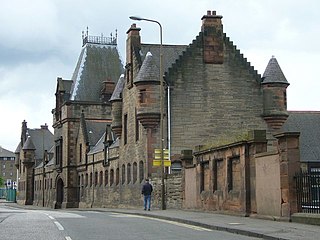
Powderhall is an area lying between Broughton Road and Warriston Road in the north of Edinburgh, the Scottish capital. Until recently it was best known for Powderhall Stadium, a greyhound racing track, which has now closed. The stadium also played host to motorcycle speedway racing from 1977 to 1995, as home to the Edinburgh Monarchs, who have since relocated to Armadale. The Powderhall Sprint, first held in 1870, was a professional footrace with handicapping of the runners. It continues, since 1999, as the New Year Sprint and is now held at Musselburgh Racecourse.
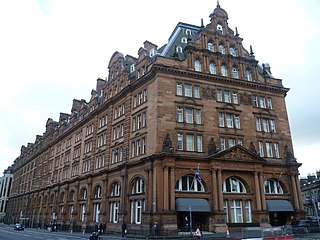
Princes Street Station was a mainline railway station which stood at the west end of Princes Street, in Edinburgh, Scotland, for almost 100 years. Temporary stations were opened in 1848 and 1870, with construction of the main station commencing in the 1890s. The station was closed completely in 1965 and largely demolished in 1969–70. Only its hotel remains, but it is no longer in railway ownership.
The Edinburgh Suburban and Southside Junction Railway was a railway company that built an east-west railway on the southern margin of Edinburgh, Scotland, primarily to facilitate the operation of heavy goods and mineral traffic across the city. The line opened in 1884. Although its route was rural at the time, suburban development quickly caught up and passenger carryings on the line were buoyant; the passenger service operated on a circular basis through Edinburgh Waverley railway station.

The Edinburgh and Dalkeith Railway was an early railway built to convey coal from pits in the vicinity of Dalkeith into the capital. It was a horse-operated line, with a terminus at St Leonards on the south side of Arthur's Seat.
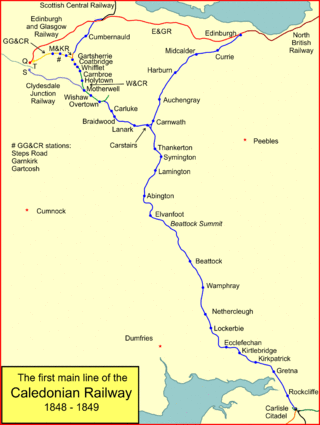
The Caledonian Railway main line in Scotland connected Glasgow and Edinburgh with Carlisle, via Carstairs and Beattock.

Leith Central Railway Station was a railway station in Leith, Scotland. It formed the terminus of a North British Railway branch line from Edinburgh Waverley. The station was built on a large scale, and it included a trainshed over the platforms.

Leith Walk is one of the longest streets in Edinburgh, Scotland, and is the main road connecting the east end of the city centre to Leith.
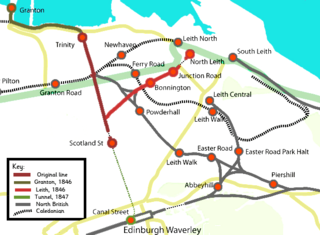
The Edinburgh, Leith and Newhaven Railway was a railway company formed in 1836 to connect the city of Edinburgh with the harbours on the Firth of Forth. When the line connected to Granton, the company name was changed to the Edinburgh, Leith and Granton Railway. It opened part of its route in 1846, but reaching the centre of Edinburgh involved the difficult construction of a long tunnel; this was opened in 1847. It was on a steep incline and was worked by rope haulage.

Piershill railway station was a railway station in Edinburgh, Scotland, on a loop off the main line. It was opened on 22 March 1868.
Portobello railway station was located at Station Brae, off Southfield Place, in the Portobello area of Edinburgh, Scotland, with footpath access from other locations. The station was opened in 1846 by the North British Railway. It replaced an earlier Portobello station nearby on the Edinburgh and Dalkeith Railway.

Powderhall Stadium, formerly the Powderhall Grounds, was a multi-sports facility overlooking the Water of Leith on Beaverhall Road, in the Powderhall (Broughton) area of northern Edinburgh, Scotland. It opened in January 1870 at the height of professional pedestrianism and was modelled on the stadium at Stamford Bridge in London. It hosted professional sprint races, track and field athletics, including the Scottish Amateur Athletics Championships on a number of occasions, professional football, international rugby, cycling, and dog races as well as boxing, quoits and pigeon shooting. For 100 years it hosted the Powderhall Sprint, the most famous professional sprint handicap in the world. With the decline of pedestrianism as a spectator sport in the 1920s it was converted to a greyhound stadium, hosting the Scottish Grand National for over sixty five years, and it also hosted professional speedway. The stadium finally closed in 1995 and the site is now a housing estate.
The Caledonian Railway lines to Edinburgh started with the main line that reached Edinburgh in 1848 as part of its route connecting the city with Glasgow and Carlisle. The potential of the docks at Granton and Leith led to branch line extensions, and residential development encouraged branch lines in what became the suburbs of Edinburgh. In 1869 a line was opened from Carfin through Shotts giving the Caledonian a shorter route between Glasgow and Edinburgh.
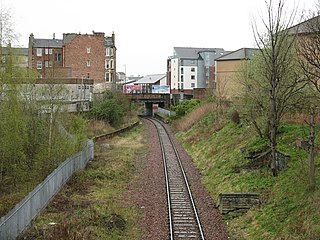
Easter Road railway station was a railway station located on the street of Easter Road in Edinburgh, Scotland from 1891 to 1947 built by the North British Railway.

Powderhall railway station served the area of Powderhall, Edinburgh, Scotland from 1895 to 1917 on the Edinburgh, Leith and Granton Line of the North British Railway.

















